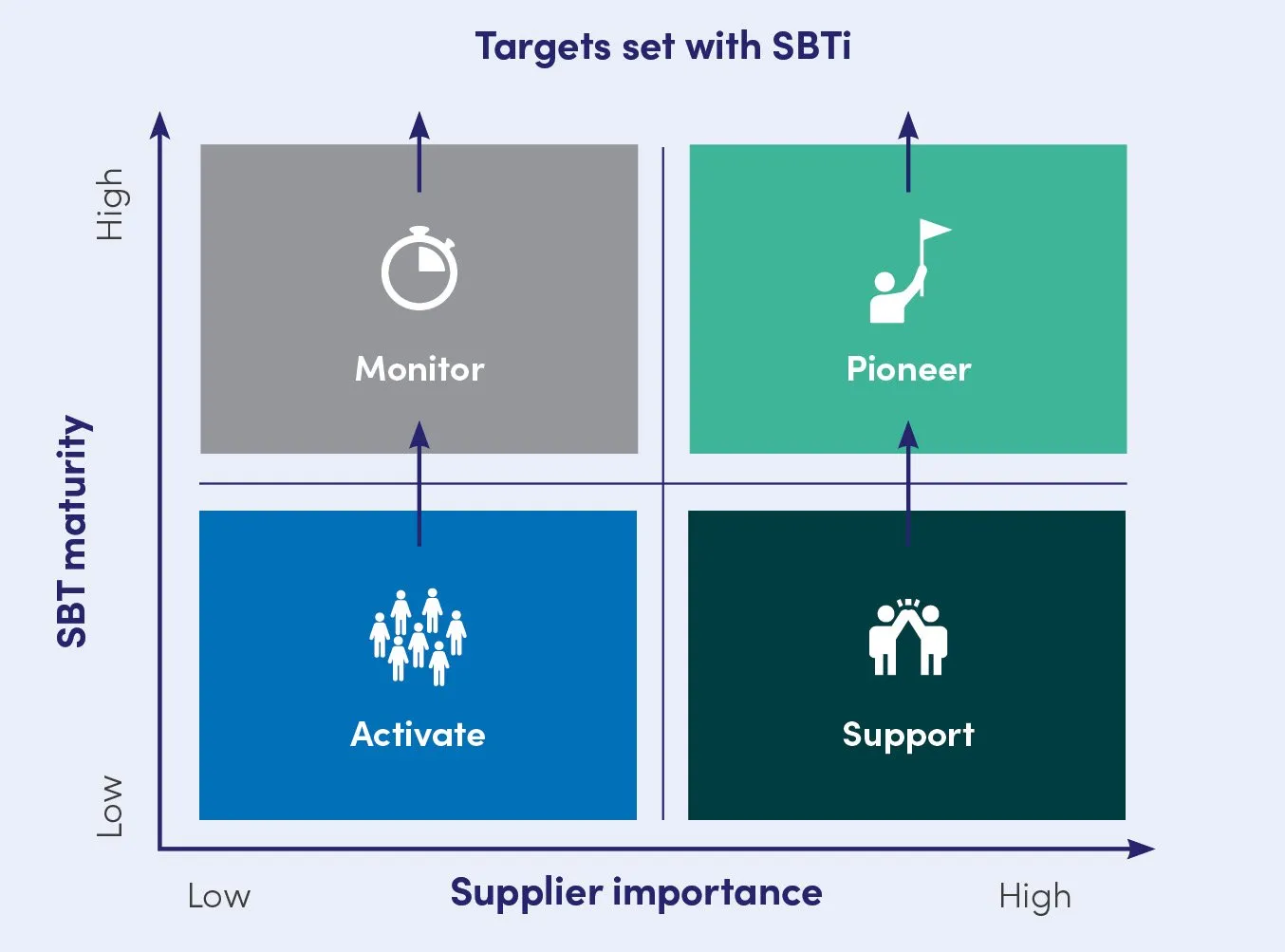- Title
-
Achieving sustainability targets via supply chains: The critical role of supplier engagement
- Section
- Insight
- Summary

Written by Efficio's Pharma Practice
For many organizations, the large portion of their carbon emissions sits within Scope 3, in which suppliers play a major role. At Efficio, we see how a Sustainability Supplier Engagement program can be key to organizations tackling the largest bulk of their carbon emissions, regardless of the industry – but how do you launch such a program?
As the climate crisis intensifies, businesses face mounting pressures to address their carbon emissions. To achieve their Net Zero targets, it is recommended that organizations set their own science-based targets (SBTs) in line with the Science-Based Targets initiative (SBTi), an internationally recognized framework for corporates to establish emission reduction targets rooted in scientific evidence and in alignment with the Paris Agreement.
Within this framework, emissions are categorized into distinct scopes.
- Scope 1: direct emissions under a company’s ownership or control
- Scope 2: indirect emissions stemming from energy consumption
- Scope 3: emissions from sources up and down a company’s value chain, from raw material production to distribution, product usage, and disposal. These extend beyond the company’s immediate control (see Figure 1)
Procurement will be a key driver in delivering carbon emissions reduction
Setting carbon emission reduction targets and progressing on these can make an impact on an organization’s Scope 1 and 2 emissions.
However, for many companies, Scope 3 accounts for the bulk of their emissions, reaching over 90% of their total emissions in some instances. Within Scope 3 categories, purchased goods and services, capital goods, and transportation, all of which arise from suppliers’ activities, are particularly significant contributors to carbon emissions. In other words, for buying organizations, Scope 3 emissions reduction presents the challenge of needing to influence factors outside of its direct remit: the suppliers operating within the end-to-end supply chain.
This is where Procurement, in collaboration with a company’s sustainability function, can make an impact by assessing, engaging with, and influencing suppliers to commit to SBTi.
Understanding and overcoming the key challenges for suppliers
Reducing carbon emissions presents considerable challenges for suppliers. The primary reason for this is the lack of data and resources needed for carbon baselining and emission calculations. In addition, sparse local regulations, complex legislation, and the costs associated with decarbonization initiatives can put suppliers off investing in the necessary changes.
When approaching their suppliers, we suggest companies follow the steps below:
- Calculate your carbon emissions baseline in order to identify relevant suppliers for the Supplier Engagement program
- Next, categorize and cluster suppliers based on their SBT maturity and importance to the organization
- Execute the Supplier Engagement program based on the uniquely defined approach per supplier cluster, recognizing that as data accuracy and spend periods evolve, so may your suppliers in scope
A Sustainability Supplier Engagement Strategy in action: A six-step approach to setting targets
A large global pharma company joined forces with Efficio to develop a strategy to engage its relevant supply base to achieve the SBTi near-term targets. For most pharmaceutical companies, Scope 3 makes up most of their emissions – and specifically emissions largely sit within Categories 1, 2, and 4 of Scope 3. In the case of our client, the large majority of their suppliers had not yet set or committed to targets with SBTi.
The team implemented a six-step approach to supplier target-setting. This approach could be similarly applied to other organizations – regardless of the industry – looking to tackle their Scope 3 emissions:
- Analyze and evaluate: Identify and pre-cluster suppliers in scope in line with SBTi criteria and needs
- Communicate: Kick off the supplier engagement process by communicating your SBT expectations
- Assess: Evaluate the suppliers’ SBT maturity status and identify which suppliers may require support
- Plan: Create a roadmap in partnership with the suppliers that are in the “Support” cluster
- Execute and implement: Enable and support suppliers to set targets by providing structured implementation help
- Monitor and manage: Monitor and manage progress against the set targets across all suppliers to ensure your organization reaches its SBTi near-term target
In the case of our client, the team had to engage with a vast number of suppliers to achieve the business’s near-term target.
We therefore segmented suppliers into four different clusters (see Figure 2) to allow for a bespoke supplier engagement strategy and approach per cluster. Clusters were based on suppliers’ SBT maturity and their relative “importance” to the business. What “importance” actually means will vary from one company to another. It may be based on the supplier’s criticality to the organization or the level of their carbon emission contributions, for instance.

Figure 2: Supplier Segmentation Matrix
The team developed tailored approaches and processes for each cluster to ensure an efficient and effective approach. Tailored content and templates were created for each supplier cluster to allow for clear communication, collaboration, and tracking. We then took a phased approach to each cluster to make sure the right capacity and capabilities were at hand to provide the best possible support to the suppliers.
This approach has several benefits:
- Suppliers are informed about their client’s sustainability targets and expectations with enough time to act
- Instead of a one-size-fits-all approach, support, guidelines, and templates can be tailored to suppliers’ needs, based on their SBT maturity
- Due to the tailored approach per cluster, the company can maintain its strong supplier relationships
- The company can conduct an informed internal planning of resource allocation over time to deploy the resources with the right skills at the right times across the procurement and sustainability functions
- It is easily scalable to a large number of suppliers. For our client, this approach helped to build a clear engagement strategy and roadmap for rolling out the Scope 3 reduction program across more than 1,000+ suppliers
Supplier engagement is key to a sustainable procurement transformation. The best results can only be achieved by effectively engaging suppliers with your organization’s strategy and working closely with them to adopt more sustainable processes and reduce emissions.
Download PDF